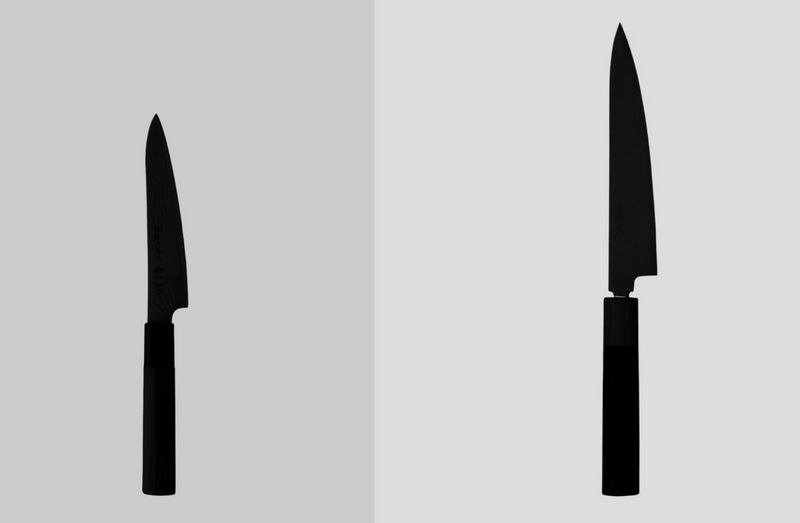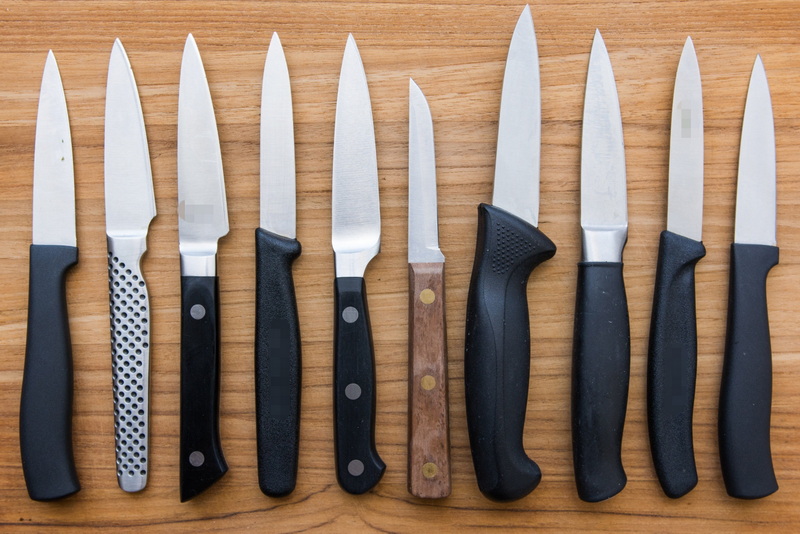- All
- Product Name
- Product Keyword
- Product Model
- Product Summary
- Product Description
- Multi Field Search
Views: 222 Author: Ann Publish Time: 2025-10-20 Origin: Site











Content Menu
>> Common Uses of a Paring Knife
>> Common Uses of a Chef Knife
● Blade Length and Shape Comparison
● Different Types within Each Category
● Choosing the Right Knife for the Task
>> Task-Specific Knife Recommendations
● Care and Maintenance Tips for Both Knives
● Why Not Use a Paring Knife for Everything?
● Frequently Asked Questions (FAQs)
>> 1. What is the main difference between a chef knife and a paring knife?
>> 2. Can I use a chef knife instead of a paring knife?
>> 3. How do I hold a chef knife properly?
>> 4. What types of foods should I never use a paring knife on?
>> 5. How often should I sharpen my knives?
When it comes to kitchen knives, two of the most essential tools every home cook should have are the paring knife and the chef knife. Although both are vital for food preparation, they serve quite distinct purposes and excel in different tasks. This article explores the key differences between these knives, helping you understand when and how to use each effectively.

A paring knife is a small, versatile knife designed for precision tasks that require careful handling. It typically features a blade ranging from 2.5 to 4 inches, with a pointed tip and either a straight or slightly curved edge. This knife is perfect for delicate jobs like peeling, coring, trimming, and making intricate cuts.
- Peeling fruits and vegetables such as apples and potatoes
- Trimming fat or small imperfections from meats
- Deveining shrimp and cleaning other seafood
- Coring fruits, like removing seeds from apples or pomegranates
- Creating small garnishes or intricate cuts for presentation
A chef knife is often called the heart of a kitchen knife set. It is larger, with a broad blade varying from 6 to 12 inches, typically curved for a rocking chopping motion. This knife is designed for multi-purpose food preparation, handling bulkier ingredients with ease.
- Chopping large vegetables like onions, peppers, and carrots
- Slicing meats and fish
- Dicing herbs
- Mincing garlic and shallots
- Disjointing or boning meat
| Feature | Paring Knife | Chef Knife |
|---|---|---|
| Blade Length | 2.5 – 4 inches | 6 – 12 inches |
| Blade Shape | Small, pointed or slightly curved | Broad, curved edge with pointed tip |
The paring knife's smaller size allows for meticulous control during delicate tasks, whereas the chef knife's size and curved blade facilitate efficient chopping and slicing of larger items.
- Paring Knife: Usually held in the hand for precise, controlled movements. Ideal for tasks that require accuracy and attention to detail.
- Chef Knife: Typically used with a rocking motion on the cutting board, enabling quick and effective chopping, slicing, and dicing.
1. Spear Point Paring Knife: The most common type, resembling a smaller chef knife, which makes it intuitive to use for those familiar with chef knives.
2. Bird's Beak Paring Knife: Has a curved blade ideal for peeling circular fruits and removing eyes from potatoes or ginger.
3. Sheep's Foot Paring Knife: Known for its flat edge and a rounded tip, useful for straight cuts and scoring.
1. French Chef Knife: Broad, heavy blade with a curved edge for rocking motions.
2. Japanese Santoku Knife: Typically shorter with a flatter blade edge, excellent for slicing and dicing without the rocking motion.
3. German Chef Knife: Balanced and heavier for tougher cuts and bulk chopping.

Understanding when to use a paring knife versus a chef knife will enhance your kitchen efficiency and safety:
- Use the paring knife for peeling, detailed trimming, and small cuts where control and delicacy are critical.
- Reach for the chef knife for bulk chopping, slicing, and more robust cutting tasks requiring speed and power.
By pairing these knives effectively, the home cook can handle virtually any kitchen task with ease.
| Task | Recommended Knife | Reason |
|---|---|---|
| Peeling apples or potatoes | Paring Knife | Small blade for control and precision |
| Chopping large vegetables | Chef Knife | Larger blade for efficiency and speed |
| Slicing meat or poultry | Chef Knife | Broad blade for smooth, even cuts |
| Deveining shrimp or peeling garlic | Paring Knife | Precision for small, delicate tasks |
| Creating garnishes | Paring Knife | Fine control for decorative cuts |
| Cutting sandwiches or rolls | Utility Knife* | Mid-sized blade for versatility |
Note: A utility knife can sometimes serve as an intermediate tool.
- Sharpen regularly: Both knives need to be sharp to maintain safety and cutting performance.
- Hand wash only: Avoid dishwashers to preserve blade integrity.
- Use appropriate cutting boards: Wooden or plastic boards prevent dulling.
- Store safely: Use knife blocks or magnetic strips to protect edges and avoid accidents.
Though versatile, a paring knife's small blade is not suited for heavy-duty chopping or slicing larger ingredients. Using it for such tasks can be inefficient, unsafe, and lead to quicker wear of the blade. Conversely, the chef knife is less suited for delicate hand-held work where precision finger control is necessary.
Both the paring knife and chef knife are indispensable tools in the kitchen, each with distinct roles tailored to different cooking tasks. The paring knife excels at precision and delicate work, while the chef knife shines in versatility and handling larger-scale cutting. Investing in good-quality versions of both knives and learning when to use each will significantly improve your cooking experience.
Mastering the use of these knives will elevate your culinary skills, making meal preparation safer, faster, and more enjoyable.

The chef knife has a larger, curved blade designed for bulk chopping and slicing, while the paring knife is small with a pointed blade ideal for precision and detail work.
While possible, a chef knife is less effective for detailed tasks and can be unsafe for small, delicate cutting.
Use a pinch grip by holding the blade between your thumb and index finger near the handle, allowing better control and natural rocking motion.
Avoid using a paring knife for chopping large vegetables or slicing thick cuts of meat, as this can damage the blade and be unsafe.
Sharpen knives regularly depending on usage, typically every few weeks to months; frequent honing between sharpening prolongs edge life.
The Ultimate Professional Knives for Halal Butchery in Middle Eastern Kitchens
Chef Knife Size Guide: Choosing Between 6″, 8″, 10″, And 12″
Custom Knife Handles: How To Design A Chef Knife That Fits Your Hand Perfectly
Chef Knife Surface Treatments Guide: From Polished Migaki To Damascus Patterns
Inside Our Professional Knife Sample Room: Quality You Can See
Universal Knife Block Buying Guide: Modern Acrylic & ABS Knife Holders for Professional Kitchens
Universal Knife Block: The Complete Guide To Modern, Hygienic Knife Storage
The Complete Guide To Red Handle Knife Sets: Style Meets Functionality in The Kitchen
Professional Knives for Halal Butchery And Middle Eastern Cuisine